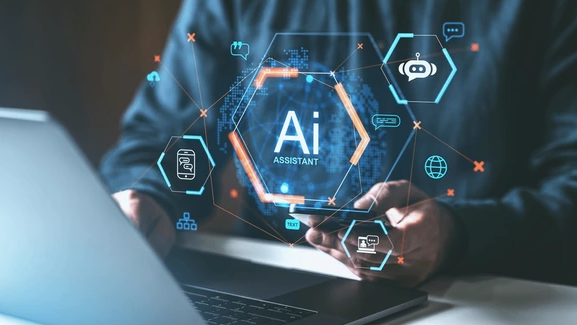Manufacturing Efficiency Redefined: An HVHI Strategy for Smart Factory AI Adoption
Manufacturing Efficiency Redefined: An HVHI Strategy for Smart Factory AI Adoption
For the past decade, the manufacturing sector has been chasing a ghost: the "Smart Factory." This vision, synonymous with Industry 4.0, promises a fully autonomous, self-optimizing ecosystem. A world of AI-driven robotics, predictive maintenance that eliminates downtime, digital twins that simulate reality, and an Industrial Internet of Things (IIoT) that connects every machine into a single, intelligent brain.

The promise is intoxicating. The reality, for most, has been a brutal disappointment.
Manufacturing companies, more than any other sector, are trapped in "pilot purgatory." They have dozens of small-scale, promising AI pilots running on isolated machines, but they perpetually fail to scale. Transformation timelines, quoted in years and costing hundreds of millions, crumble under their own weight. The C-suite loses patience, the factory floor resists change, and the project collapses, leaving behind a "data lake" nobody uses and a few expensive sensors.
The problem is not the technology. AI, computer vision, and IIoT are more powerful than ever. The problem is the model. The manufacturing industry is trying to execute the most dynamic technological leap in its history using a "waterfall" mindset—a slow, rigid, linear approach that is fundamentally incompatible with innovation.
This low-velocity, high-capital, risk-averse model is broken. To survive and thrive, the industry needs a new operating system. It needs a strategy built for speed, agility, and measurable results. It needs the High-Velocity, High-Impact (HVHI) model. This is the only framework that can cut through the gridlock, streamline processes, and turn the promise of the Smart Factory into a production-floor reality.
Part 1: The Gridlock: Why "Smart" is So Slow and "Impact" So Low
To apply the HVHI solution, we must first diagnose the disease. The manufacturing world is uniquely burdened by four systemic forces that create a low-velocity, low-impact environment.
1. The "Pilot Purgatory" Trap This is the single greatest killer of Smart Factory initiatives. A data science team proves, in isolation, that an AI model can predict a failure on a single bearing (a "pilot"). It's a technical success, but it has no impact on the business's bottom line. It's not integrated into the maintenance workflow, it's not scaled to the other 500 bearings, and the line supervisor still relies on their spreadsheet. The project is a "Low-Impact" win that, due to its isolation and failure to scale, creates no real velocity. The company has a portfolio of "wins" that add up to zero.
2. The Great OT/IT Chasm In no other industry is the cultural and technical divide more profound than the one between Operations Technology (OT) and Information Technology (IT).
-
OT (The Factory Floor): This world lives by "uptime" and "safety." Its mantra is: "If it ain't broke, don't touch it." They work with 20-year-old, proprietary PLCs (Programmable Logic Controllers) and SCADA systems. Their concept of "velocity" is non-existent; their concept of "risk" is absolute.
-
IT (The Data Center): This world lives by Agile, cloud, and data. Their mantra is: "Move fast and deploy daily." They see the factory's legacy systems as an impenetrable, hostile fortress.
When IT tries to deploy a new AI solution, OT sees it as a threat to stability. This chasm becomes a "Velocity Black Hole" where all projects grind to a halt in a morass of security reviews, jurisdiction battles, and mutual distrust.
3. The Burden of Brownfield and Monoliths "Greenfield" factories—built new from the ground up—are rare. The vast majority of manufacturing is "Brownfield," meaning it must operate on a complex, brittle, and aging foundation of legacy machinery. These machines are often controlled by monolithic, on-premise MES (Manufacturing Execution Systems) that are 15 years old. Getting data out is a nightmare. Making a single change to the line's software can require a six-month test-and-validation cycle. This is the very definition of a Low-Velocity architecture.
4. The ROI Black Hole The "waterfall" approach to transformation demands a massive, upfront CAPEX budget. A "five-year, $200M" plan is presented, with a theoretical ROI in Year 5. In today's volatile market, this is a fantasy. CFOs are (rightfully) skeptical. The business cannot wait five years for a return. When the project inevitably hits a delay in Year 2, the funding is pulled.
Part 2: The "High-Velocity" (HV) Engine: Building the Factory's Nervous System
The HVHI model first tackles speed. The "High-Velocity" (HV) component is not about being reckless; it is about systematically removing friction. In manufacturing, this requires a radical new approach to technology and teamwork.
1. The "DevOps" for Manufacturing: Forging the IT/OT Pod The OT/IT chasm is a cultural problem that must be solved with a structural change. The HVHI model borrows from the software world's "DevOps" revolution. It breaks down the silos by creating small, autonomous, cross-functional "Smart Factory Pods."
A pod is not a committee. It is a dedicated, full-time team with a single mission. A typical pod would include:
-
1 OT Engineer (who knows the PLC and the physics of the machine)
-
1 IT Data Scientist (who can build the AI model)
-
1 Line Supervisor (the "customer" who knows the real-world workflow)
-
1 Software/Data Engineer (who can get the data flowing)
This pod is given a single, high-impact goal (more on that later) and the autonomy to achieve it. This co-location and shared ownership is the only way to bridge the chasm. The OT engineer learns the power of data; the IT engineer learns the reality of physical constraints.
2. Bypassing the Monolith: The IIoT Abstraction Layer You cannot rip and replace a $50M assembly line. The HV model uses a "wrap-and-adapt" strategy. Instead of replacing the monolithic MES, you wrap it in a modern data abstraction layer.
This is the role of an IIoT Platform. This platform acts as a universal translator. It uses modern sensors and API gateways to pull data from old PLCs, new robots, and the MES alike. It normalizes this data and makes it available via a simple, secure API.
This is the ultimate velocity-enabler. An AI developer no longer needs to spend six months learning a 30-year-old proprietary protocol. They can just query the platform's API to get real-time data from Line 3. It decouples the "fast" world of AI software from the "slow" world of physical hardware, allowing them to evolve at different speeds.
3. "Agile for Atoms, Not Just Bits" "Agile" in manufacturing sounds absurd. You can't "sprint" a new stamping press. But you can—and must—apply agile principles to the process of optimization.
-
Software: The AI models for quality control or prediction are not "finished." They are in a constant state of CI/CD (Continuous Integration / Continuous Deployment). The pod should be able to tweak, test, and re-deploy a computer vision model in a single day, not a single quarter.
-
Hardware: Rapid prototyping with tools like 3D printing allows the pod to design, print, and test a new part, jig, or robotic gripper in 24 hours.
This "good enough for now, better tomorrow" mindset is a direct assault on the "perfect but late" waterfall model.
Part 3: The "High-Impact" (HI) Compass: From Pilot Purgatory to Scaled Production
Velocity is chaos unless it is aimed. This is the "High-Impact" (HI) compass. It is the ruthless prioritization framework that ensures the organization's newfound speed is directed at the one or two things that actually matter.
This is how we escape "pilot purgatory."
1. The "North Star Metric": From Tech Milestones to Business Outcomes The "High-Impact" model is guided by a "North Star Metric." This is a single, quantifiable, business-centric goal that the entire pod is measured against.
-
Low-Impact (The Pilot): "Successfully deploy an AI model on Machine 7." (This is a task. Who cares?)
-
High-Impact (The Outcome): "Reduce unplanned downtime on Bottleneck Line 3 by 20% in Q1."
-
High-Impact (The Outcome): "Increase Overall Equipment Effectiveness (OEE) by 5 points."
-
High-Impact (The Outcome): "Reduce the First-Pass-Yield scrap rate from 4% to 2%."
When this is the goal, the pod is free to use any tool to achieve it—AI, a new sensor, a 3D-printed part, or simply changing a process. This outcome-driven focus prevents them from falling in love with a specific technology (like AI) and forces them to solve the actual business problem.
2. The HVHI "First Strike" Targets for AI Adoption An HVHI strategy does not try to "boil the ocean." It identifies the most critical, high-impact problems and attacks them in rapid succession. For most manufacturers, the AI "first-strike" list is clear.
-
Target 1: Predictive Maintenance (PdM) on the Bottleneck. This is the classic. Unplanned downtime is the #1 killer of factory efficiency. The HVHI pod's first sprint is not to deploy PdM everywhere. It is to deploy it on the single constraint machine—the bottleneck—that governs the entire plant's throughput. A 10% reduction in downtime on the bottleneck is not a 10% win; it's a 10% increase in the entire factory's output. This is a massive, high-impact win that funds all future sprints.
-
Target 2: AI-Powered Quality Control (Computer Vision). Manual, end-of-line visual inspection is slow, expensive, and notoriously error-prone. An AI-powered computer vision system is a perfect HVHI solution. It is High-Velocity (inspects 100 parts per second, 24/7) and High-Impact (catches defects earlier, reducing scrap and labor costs). This provides a tangible, immediate ROI.
-
Target 3: The Digital Twin as an HVHI Accelerator. The "Digital Twin"—a real-time, physics-based simulation of a production line—is the ultimate HVHI tool. Why? Because it allows for High-Velocity experimentation with zero High-Impact risk.
-
Old Way (Low-V): Want to test if changing the line speed will increase output? You have to shut down the physical line, make the change, run it for a week, and risk creating a massive downstream problem.
-
HVHI Way (High-V): You make the change in the digital twin. The AI-powered simulation runs a virtual "week" in 30 seconds and tells you the precise outcome—"This change will increase output by 3% but will cause a critical jam at the buffer station in 72 hours." You've gained a week of knowledge, with zero risk and zero cost.
-
Part 4: The HVHI Mandate: The New Transformation Playbook
Let's contrast the two models for adopting Smart Factory AI.
The Old "Waterfall" Model (Low-Velocity, Low-Impact):
-
Year 1: A central committee spends 12 months writing a 5-year, 200-page "Digital Transformation" roadmap. A $100M budget is requested.
-
Year 2: A large systems integrator is hired. They begin the 18-month process of replacing the core MES. The factory floor sees no change, only disruption.
-
Year 3: The project is 50% over budget and behind schedule. The C-suite, seeing no ROI, cuts funding. The project dies.
The New "HVHI" Model (High-Velocity, High-Impact):
-
Week 1: An autonomous IT/OT pod is formed. Their North Star Metric is "Reduce unplanned downtime on Line 3 by 20%." Their timeline is 8 weeks.
-
Week 2-7: The pod uses the IIoT platform to get data from the bottleneck machine. They build, test, and deploy a "good enough" PdM model. They work with the maintenance team to integrate the AI alerts into their actual workflow.
-
Week 8: The pod demonstrates a 12% reduction in downtime. The win is tangible and measurable. The CFO sees an immediate, positive P&L impact.
-
Week 9: The pod's success is celebrated. The model is funded for its next 8-week sprint: "Scale the PdM model to the rest of the line" or "Tackle the #2 problem: scrap rate."
This is the new playbook. The HVHI model is not a "project"; it is a process. It's a factory-floor "skunkworks" that builds momentum with every small, fast, tangible victory. It streamlines processes by breaking them down into 8-week, outcome-driven sprints, and it cuts the transformation timeline from "years" to "quarters."
The Smart Factory is not a far-off destination. It is a continuous, iterative process of improvement. The HVHI model provides the engine (Velocity) and the compass (Impact) to finally stop planning for Industry 4.0 and start executing it.








